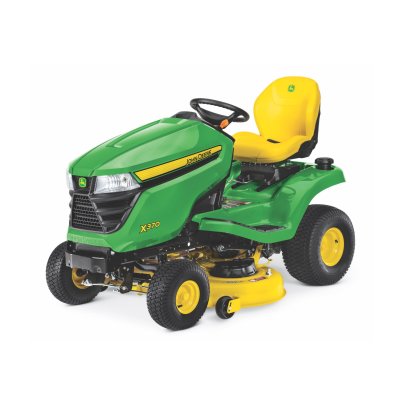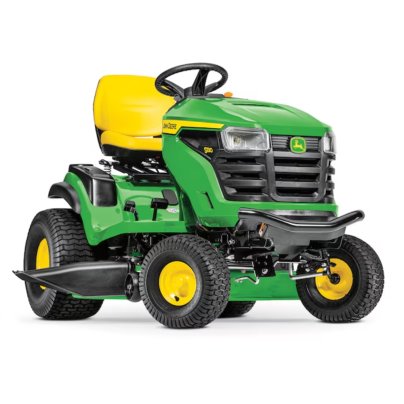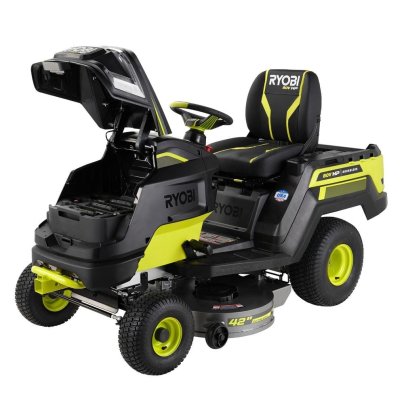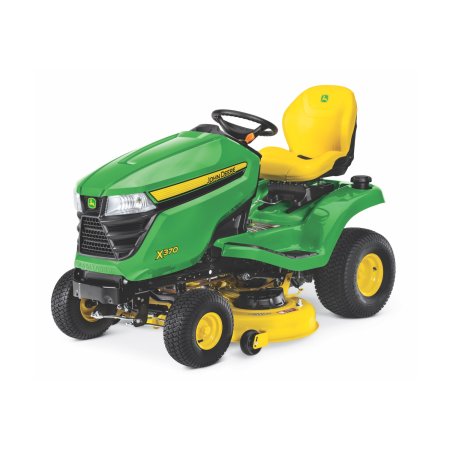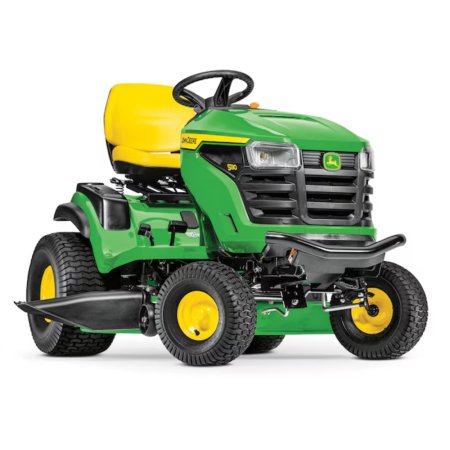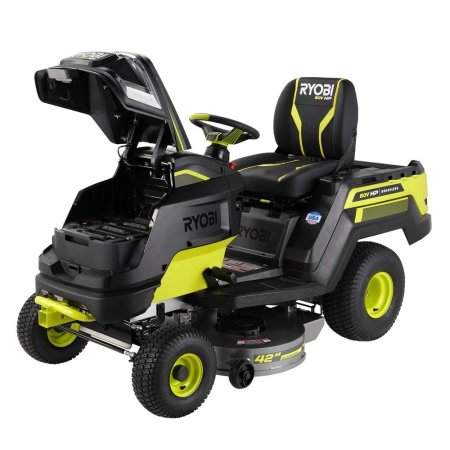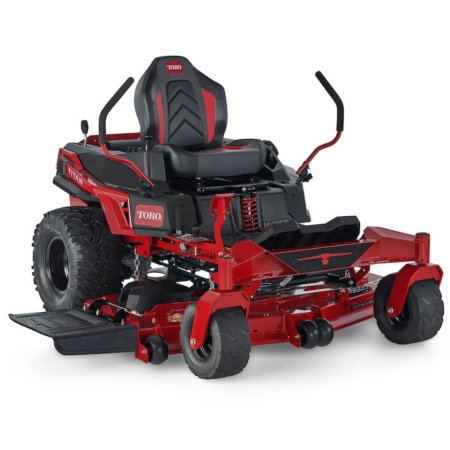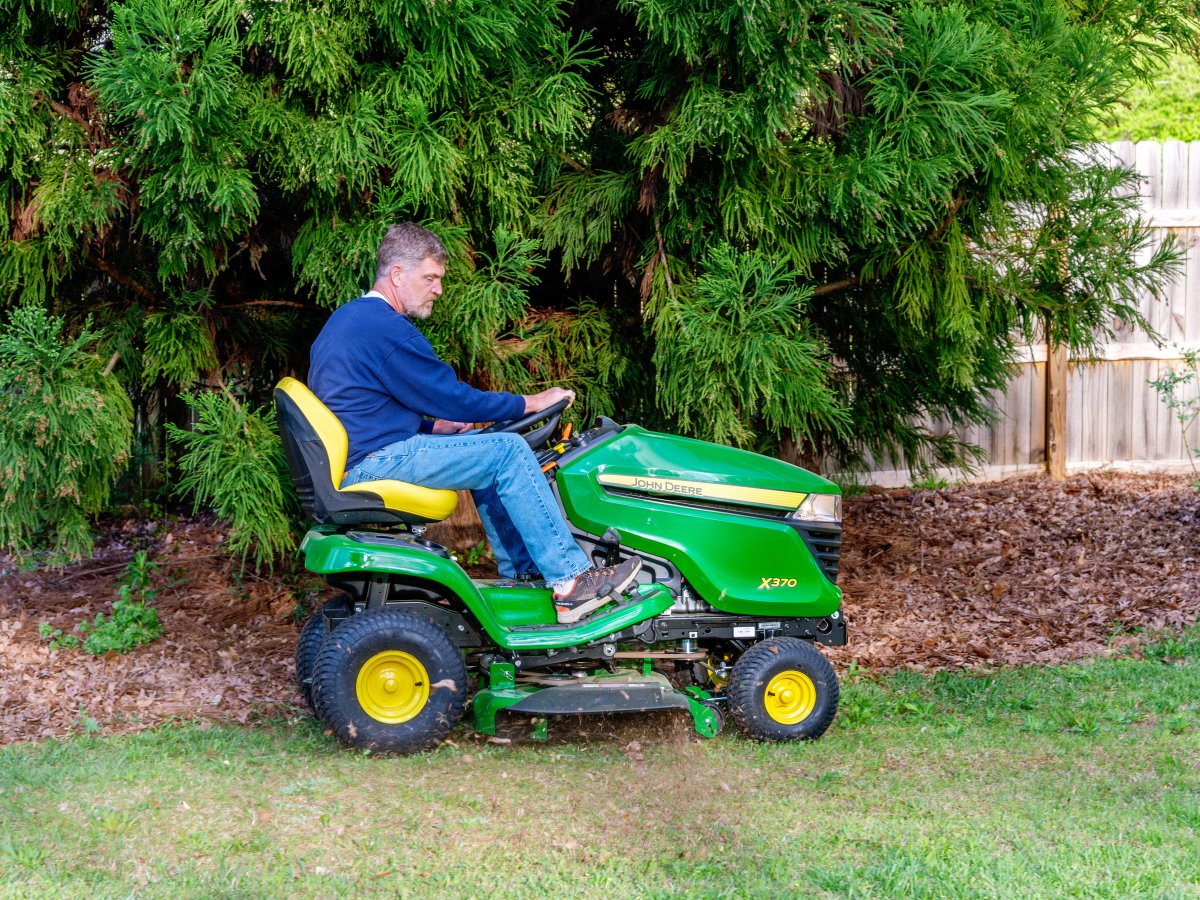
We may earn revenue from the products available on this page and participate in affiliate programs. Learn More ›
If your landscape is large and hilly, mowing the lawn can be a real pain, but finding the right riding lawn mower for hills can make it a whole lot easier. Using a walk-behind or self-propelled mower may be fine for small yards, but it is time-consuming and exhausting. A ride-on mower, on the other hand, reduces mowing time and effort and offers other features that make yard care easier.
That being said, not all driving lawn mowers are cut out for working on slopes or rough terrain. The key features for these conditions are traction, balance, and power. We’ve tested lots of zero-turn mowers and lawn tractors, but only a few of them are built to take on the rigors of rolling landscapes. We tested some of the market’s most respected riding lawn mowers to see how they fared in various conditions. Ultimately, our favorite was the John Deere X370 Lawn Tractor, which is powerful, feature packed, comfortable, and smooth in operation—even over rough, steep terrain. In this guide, we will review the best riding lawn mowers for hills, discuss their performance in our tests, and share the considerations that you’ll want to bear in mind before buying one.
- BEST OVERALL: John Deere X370 Lawn Tractor With 42-Inch Deck
↓ Jump to Review - BEST BANG FOR THE BUCK: John Deere S130 Lawn Tractor
↓ Jump to Review - BEST ELECTRIC: Ryobi 80V 42-Inch Electric Riding Lawn Tractor
↓ Jump to Review - BEST ZERO-TURN: Toro 60-Inch Titan MyRide Zero-Turn Mower
↓ Jump to Review

Lawn Mowers for Hills Product Comparison
| Product | Power Source | Type | Cutting Width |
| John Deere X370 Lawn Tractor With 42-Inch Deck | 21.5-horsepower (hp) gas engine | Lawn tractor | 42 inches |
| John Deere S130 Lawn Tractor | 22-horsepower gas engine | Lawn tractor | 42 inches |
| Ryobi 80V 42-Inch Electric Riding Lawn Tractor | Three 80-volt (V) 10-amp-hour (Ah) lithium-ion batteries | Lawn tractor | 42 inches |
| Toro 60-Inch Titan MyRide Zero-Turn Mower | 26 hp gas engine | Zero-turn riding lawn mower | 60 inches |
Our Top Picks
The best lawn mowers for hills should have the right combination of power, cutting width, and fuel type, but the manufacturer specs only tell part of the story. In the following reviews, we’ll share our performance observations from testing.
Best Overall
John Deere X370 Lawn Tractor with 42-Inch Deck
What We Like
- Comfortable ride and smooth steering
- Crisp, clean cut with evenly distributed clipping discharge
- Easy to operate and adjust
- Power steering, cruise control, and wet disc brakes
What We Don’t Like
- No locking differential; traction may slip in certain conditions
Product Specs
- Power source: 21.5-horsepower (hp) gas engine
- Type: Lawn tractor
- Cutting width: 42 inches
Our Ratings: Ease of Use 5/5; Comfort 5/5; Handling 5/5; Cut Quality 5/5; Value 4.7/5
For the toughest terrain, we prefer the stability of a tractor lawn mower like this one. The X370 is a rugged and reliable model that’s ideal for year-round property maintenance. It comes equipped with a 21.5 hp John Deere iTorque engine, a 42-inch Accel Deep mowing deck, and two-wheel power steering. Everything about this mower makes yard work more enjoyable. The 18-inch high-back seat provides a seriously comfortable ride over rough terrain, with adjustable suspension springs and a smooth-sliding 15-position fore-aft adjustment system. The power steering system allows it to carve incredibly tight turns with minimal operator strain.
As a hill mower, the X370 climbed and descended slopes with excellent control, and it did better than most while following the contours perpendicular to the slope. We especially appreciated the power steering due to the control it gave us while driving over ruts, roots, and rocks. When it came to mowing, the deck produced strong airflow that lifted grass blades upright to ensure a crisp, clean cut without needing to double-mow or slow to a crawl. Even with taller grass, it discharged fine grass clippings evenly across a wide area so that they disappeared into the lawn. The hydraulic deck lift and deck height dial made these functions almost effortless. The X370 can easily be upgraded with a mulch kit or bagging system (sold separately).
Get the John Deere X370 riding lawn mower at John Deere.
Best Bang For The Buck
John Deere S130 Lawn Tractor
What We Like
- Offers plenty of power at an affordable price
- Hydrostatic transmission eliminates gear selection
- Push-button blade engagement system
- Easy maintenance; 30-second oil change system
- Compatible with wide range of John Deere accessories
What We Don’t Like
- Takes longer to mow large properties
Product Specs
- Power source: 22-horsepower gas engine
- Type: Lawn tractor
- Cutting width: 42 inches
Our Ratings: Ease of Use 5/5; Comfort 5/5; Handling 4.5/5; Cut Quality 4.5/5; Value 4.7/5
The John Deere S130 lawn tractor is a small riding lawn mower that rides comfortably, maneuvers deftly, and offers numerous convenience features at an affordable price. This riding mower for hills features a 22 hp engine that powers the 42-inch mower deck, allowing it to cut through dense grass or climb inclines with ease. It is also equipped with a hydrostatic transmission that makes adjusting speeds smooth and easy, and its cruise control function allows users to lock in that perfect pace.
This affordable tractor has many convenient features. An easy-to-read fuel gauge ensures the operator always knows how much gas is left while climbing hills. The ergonomically designed operator’s station is spacious, and the mower’s 30-second oil-change system doesn’t require any tools.
During testing, we noted that the S130 offers a higher vantage point than other lawn tractors. It gave us better visibility for mowing a steep slope and steering around obstacles, and it still felt stable operating on hills and uneven terrain. It does not have a locking differential gear, but its traction was good on all but the steepest slopes and in wet conditions. It also came with several convenience features we appreciated, such as an LCD fuel gauge on the dash, a spring-return choke lever, and electric blade engagement. We really liked that the fuel filler was located at the rear of the machine, making it easy to top off the gas and avoid spills. With the 42-inch deck, it’s probably best for yards up to about 1 acre in size.
Read our full review: John Deere S130 Lawn Tractor
Get the John Deere S130 riding lawn mower at John Deere.
Best Electric
Ryobi 80V 42-Inch Electric Riding Lawn Tractor
What We Like
- Cuts up to 2 acres per charge
- Recharges in just under 2.5 hours
- Cross Cut blade system for fast, clean mowing
- Versatile with USB ports, storage compartments, front/rear tow hitches
What We Don’t Like
- Thin mower blades are more easily damaged
- Less maneuverable in tight spaces than other tractors
Product Specs
- Power source: Three 80-volt (V) 10-amp-hour (Ah) lithium-ion batteries
- Type: Lawn tractor
- Cutting width: 42 inches
Our Ratings: Ease of Use 4/5; Comfort 5/5; Handling 4.5/5; Cut Quality 4.5/5; Value 4.3/5
For a hillside mower that’s nimble and quiet yet strong and capable, the Ryobi 42-inch electric lawn tractor could be a great choice. Three brushless electric motors and three 80V 10 Ah batteries deliver mowing power equivalent to a 21 hp gas engine—all without gasoline and engine maintenance, and with significantly less noise. It cuts up to 2 acres per charge, and the batteries recharge in just under 2.5 hours with the included hypercharger and onboard charging port.
The Ryobi electric riding mower’s design is centered around versatility. It features a 42-inch cutting deck with twin crosscut blade assemblies for a precise cut. For expanded capabilities, the tractor also features a large covered storage compartment under the hood, an open rear hauling compartment, and universal 2-inch square towing hitch receivers at the front and rear. A full-color LCD screen displays charge status, battery level, and remaining runtime.
This lawn tractor did a great job mowing our rolling terrain. It was a bit heavier than some of the other riding mowers, and that extra weight translated to sure-footedness while navigating up, down, and across the plane of the slopes. Most importantly, it had plenty of runtime. Mowing our 1-acre lot (which is about half grass) left us with 54 percent charge left in the batteries. As for storage and hauling, the front compartment was large enough to stow a 12-inch chainsaw, work gloves, and a can of bee spray—and we were able to load five bags of mulch into the rear bed with room to spare. That being said, the added length reduced maneuverability to a degree.
Get the Ryobi riding lawn mower at The Home Depot.
Best Zero-Turn
Toro 60-Inch Titan MyRide Zero-Turn Mower
What We Like
- 23-inch tires enable easy rugged terrain travel
- Powerful engine propels mower up to 8.5 miles per hour (mph)
- Roll bar keeps users safe on uneven terrain
- Impressive width mows large spans in fewer passes
What We Don’t Like
- Users are advised against climbing inclines greater than 15 degrees
Product Specs
- Power source: 26 hp gas engine
- Type: Zero-turn riding lawn mower
- Cutting width: 60 inches
Our Ratings: Ease of Use 4.5/5; Comfort 5/5; Handling 4.5/5; Cut Quality 5/5; Value 5/5
Although riding lawn tractors often outmaneuver zero-turn mowers on hills, a big, heavy zero-turn model could be the right choice for larger properties with plenty of open space. Weighing over 800 pounds, the Toro Titan zero-turn mower gets more traction than other residential zero-turn mowers. Plus, it features large, grippy 22-inch tires to help propel it over rough terrain. Its 26 hp commercial-grade Kohler engine powers the 60-inch deck across large properties with obstacles without a problem.
The Toro Titan MyRide is a fast and durable mower, and the power doesn’t come at the cost of comfort. It can zip across open ground at speeds up to 8.5 mph. It features a heavy-duty 10-gauge steel mowing deck and a premium suspension system for maximum comfort on tough terrain. Just remember that this is a zero-turn mower, so it shouldn’t climb slopes of more than 15 degrees. For added safety while working on uneven ground, Toro offers an aftermarket rollover protection system for their zero-turn mowers. For the hills it can safely climb, it’ll cut them in much fewer passes thanks to its impressive 60-inch mowing deck.
This was the most powerful and most comfortable riding mower we tested for this guide, which is exactly what a large lawn needs. Mowing huge 5-foot-wide swaths, even at half of the maximum speed, we were able to cut a little more than 1 acre in just 25 minutes. The adjustable suspension system worked perfectly, too, allowing us to comfortably maintain speed over smooth and bumpy terrain, uphill and downhill. On mild slopes with few obstacles, the Titan could save an immense amount of mowing time and potentially cut fuel costs. But we also noted that operating the mower perpendicular to the slope angle severely limited safe maneuvering. In addition, the wide deck became problematic when it came time to navigate narrow pathways and walk-through gates.
Get the Toro riding lawn mower at Tractor Supply Co.
Jump to Our Top Picks
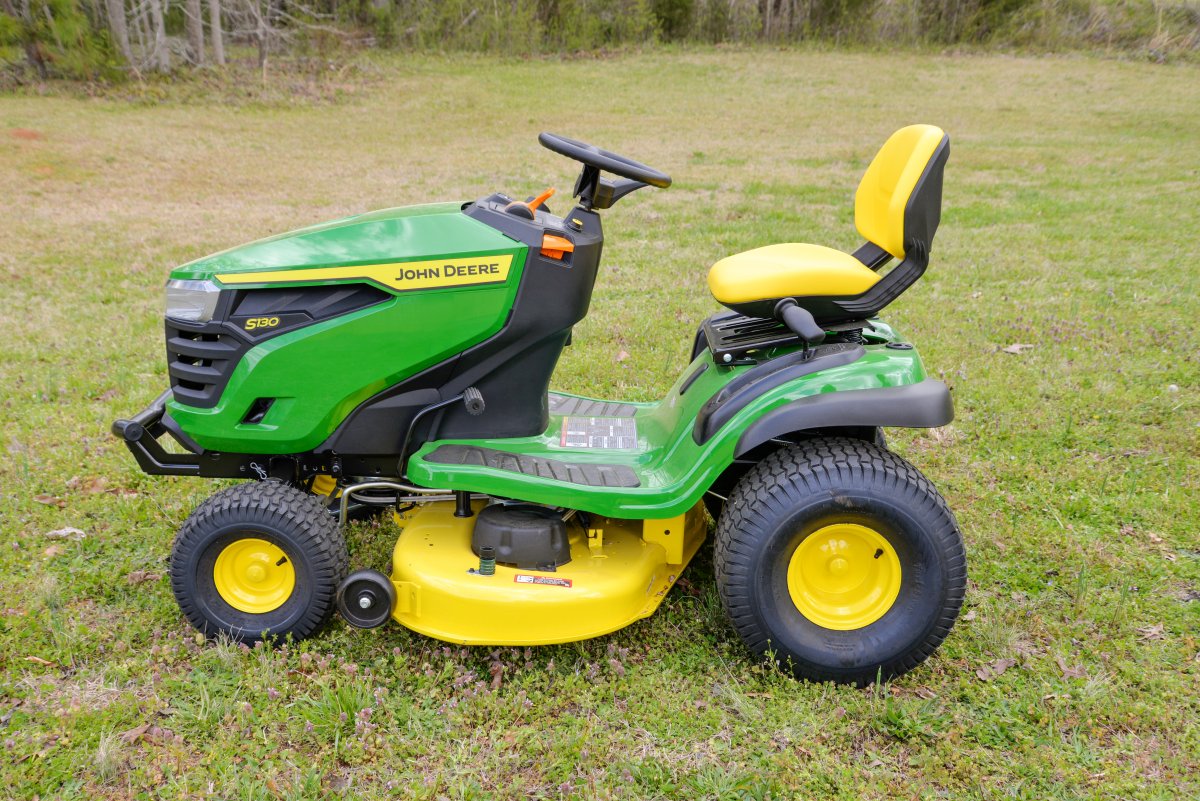
How We Tested the Best Riding Lawn Mowers for Hills
| Testing stats | |
| Products tested | 4 |
| Hours spent testing | 15 |
| Tests performed | 5 |
| Price range | $2,900 to $7,100 |
We spent 15 hours cutting more than 20 acres of mixed fescue, centipede grass, and Bermuda grass. Each riding lawn mower navigated a hilly route that included tree rings, landscape beds, fence lines, narrow corridors, and wide-open spaces. We evaluated the mowers for hillside mowing maneuverability, mowing speed, cut quality, ease of use, and operator comfort. We noted our observations and scored each mower on a rubric, with reference to the manufacturer’s specifications and our subjective criteria. Finally, we awarded the titles based on each model’s particular strengths. Based on performance results, each of these riding lawn mowers proved worthy of consideration for hilly or uneven yards.
| Ease of Use | Comfort | Handling | Cut Quality | Value | |
| John Deere X370 Lawn Tractor With 42-Inch Deck | 5 | 5 | 5 | 5 | 4.7 |
| John Deere S130 Lawn Tractor | 5 | 5 | 4.5 | 4.5 | 4.7 |
| Ryobi 80V 42-Inch Electric Riding Lawn Tractor | 4 | 5 | 4.5 | 4.5 | 4.3 |
| Toro 60-Inch Titan MyRide Zero-Turn Mower | 4.5 | 5 | 4.5 | 5 | 5 |
What to Consider When Choosing a Riding Lawn Mower for Hills
Pinpointing the best lawn mower for hills requires some research. Yard size and terrain type are key factors to take into account, while motor and fuel type, weight, cutting width, and tire type and size can make the difference between a quick and easy mow and a lengthy chore.
Types of Riding Lawn Mowers
Although certain walk-behind or stand-on mowers may get the job done, the best riding lawn mower for steep hills will likely fall into one of three categories: lawn tractors, rear-engine mowers, or zero-turn mowers. Each has its own capabilities and specialties. Finding the right one means identifying which characteristics work best for a given situation.
Lawn Tractors
Lawn tractors employ wide, mid-mounted cutting decks rather than front-mounted decks. Operators use a steering wheel and pedal system similar to that of an automobile to cut large swaths of grass quickly and easily. They also tend to be equipped with powerful engines, which increases their overall weight.
The main difference between lawn tractors and garden tractors is versatility. Lawn tractors are primarily used to mow lawns, while garden tractors may also plow snow, tow equipment, and perform other lawn maintenance duties.
Manufacturers offer many accessories that can augment a mower’s functionality, such as grass sweepers, fertilizer spreaders, aerators, rollers, and sprayers.
Rear-Engine Mowers
A few subtle differences set rear-engine mowers apart from tractor mowers. As the name implies, the engine sits on the rear of the mower. These mowers tend to be lighter and less powerful than other types—a trade-off that aids maneuverability and energy efficiency at the cost of valuable torque.
These mowers have smaller deck sizes than other riding mowers, ranging between 28 and 34 inches. The smaller cutting deck translates to longer mowing times compared to larger mowers with wider decks. Rear-engine mowers are more maneuverable thanks to a smaller turning radius than tractor mowers, making them a middle ground between heavier mowers that require more space and zero-turn mowers that turn on a dime.
Because of their smaller size and reduced power needs, rear-engine mowers tend to be less expensive than other types. They make great mowers for yards smaller than an acre.
Zero-Turn Mowers
Zero-turn mowers are best for yards with curves and tight turns. Their name comes from the dual hydrostatic transmissions that drive the side wheels independently—a single lever operates each transmission. Pressing both levers forward results in a straight course, while depressing one lever allows the mower to make a complete turn in a space the size of the mower.
For those with a large lawn or limited time to mow, zero-turn mowers offer an excellent solution. These mowers tend to be faster than lawn tractors, averaging 6 to 8 mph versus lawn tractors’ 3 to 4 mph. Zero-turn mowers are usually more comfortable, as their designs typically incorporate a large, padded pilot’s seat that’s easy on the body.
Zero-turn mowers have drawbacks, including reduced stability. Operators should not attempt to operate these mowers on slopes greater than 10 degrees. Because of a high center of gravity, mowing on steep slopes presents a tipping danger. Additionally, the dual-transmission design requires the throttles to be in the neutral position to stop without the advantage of a dedicated braking system, making them difficult to control on downhill paths.
Yard Size and Terrain Type
The first things to consider when selecting the best riding lawn mowers for hills are the yard size and terrain. Riding mowers can handle varying types of terrain. Most mowers include some height adjustment, but root-ridden or pockmarked lawns require higher clearances to prevent damage to the blade and minimize the damage of getting stuck.
Yard size determines one essential aspect of mowing: how much time it takes to do the job. Consider the size of the yard against the speed of the mower. Huge yards can take hours to mow, so users can cut down on mowing time by getting a mower that’s fast and efficient enough to get the job done in a reasonable amount of time. However, a small riding mower may be more than suitable for yards that are 2 acres or smaller.
Gas vs. Electric
The progression of battery technology in recent years has made it easier to do without cords. Battery-powered riding lawn mowers that do not require an electrical tether have gained popularity, largely because they’re quiet, light, easy to maintain, and environmentally friendly. However, battery life is a crucial consideration for an electric riding lawn mower. Running out of battery power before finishing the job could mean a delay of several hours while the mower recharges.
Traditional gas-powered motors are more powerful than their electric counterparts at the expense of being far noisier and emitting exhaust fumes. Gas mowers provide more torque, are able to cut through overgrown or thick grass more efficiently, and refuel faster. However, they require oil, filter, and spark plug changes as well as other maintenance. Those with large properties or very dense grass will likely want to lean toward a gas-powered motor with a large fuel capacity for its superiority in runtime and power.
Cutting Width
The cutting width, which is sometimes referred to as the mower deck or cutting deck, refers to how wide a swath a mower cuts in one pass. Mowers with wider cutting decks require fewer passes to mow a lawn.
Small lawns measuring ½ acre or less require a small lawn mower with a cutting width of fewer than 40 inches. For ½-acre to 2-acre lawns, 42- to 48-inch-wide decks work well. If the lawn is larger than 3 acres, search for a cutting deck 50 inches or broader. The search for the best riding lawn mowers for hills or flat properties should include comparing yard size against cutting width to ensure that the mower can finish the job in a reasonable amount of time.
Horsepower
Riding lawn mowers can be heavy. Since they are self-propelled, the engine needs to be powerful enough to move the machine at a reasonable speed, cut through dense vegetation, and support a rider’s weight across varying terrain.
Smaller and lighter mowers do not have the same power as heavier lawn tractors with large engines. For small yards, less energy is required. In the sub-acre range, look for a mower with at least 14 hp. Owners of yards 1 to 2 acres in size will be happy in the 14 to 16 hp range, while powerful mowers in the 18 to 24 hp range are suitable for yards of 3 acres or more.
Riding lawn mowers run the gamut from bare-bones models with efficient engines to high-end, feature-rich models with enough horsepower to perform nearly all lawn maintenance tasks. Like automobiles, more powerful mowers tend to be more expensive and less efficient than their lighter counterparts.
Brushed vs. Brushless Motor
Brushed and brushless motors differ in their methods of power generation. The “brush,” which is only found in electrical motors, refers to a bundle of material (typically carbon wires) used to transmit electrical energy that spins the riding mower’s driveshaft. Brushless motors rely on magnetic force rather than physical contact to drive the motor.
Brushless motors are quieter than brushed motors and sense the amount of energy required to continue operation, adjusting the power to appropriate levels. They require less maintenance because they have fewer mechanical parts subject to wear and tear.
Brushed motors are louder due to the metal continually making and breaking magnetic connections. They’re generally less desirable than brushless motors, but they’re usually less expensive.
Tires
Aside from the blades, the tires are the only part of the lawn mower that actually touches the ground. The right tires are critical for traction and safety.
- Lug tires are thick, sturdy tires designed for traction. Blocks of rubber separated by a channel create grip. They are handy on wet, slippery, and sloped surfaces and are most often found on lawn tractors. Lug tires are not ideal for pristine grass, as they tend to damage the turf.
- Smooth tires help prevent ruts and damage to manicured lawns. They’re not well suited to mowing on hills or slopes due to lack of traction.
- Turf tires combine characteristics of both lug and smooth tires. These tires tend to be wider, allowing better distribution of the mower’s weight over the tire’s surface area. Turf tires provide a decent grip without chewing up the lawn as much as a lug tire and provide good traction on slopes and hills.
Weight
Tractors and lawn riding mowers weigh around 500 pounds on average, and the engine accounts for 18 to 25 percent of their total weight. More powerful mowers may tip the scale at up to 600 pounds, while lightweight electric models can weigh as little as 400 pounds.
Electric mowers are the lightest type of mower. Their lack of a heavy internal combustion engine significantly reduces their weight.
Zero-turn mowers are the heaviest type of riding mower. A light zero-turn mower may weigh up to 650 pounds. Heavier models can weigh up to 1,000 pounds. While heavier mowers are more powerful, they can sink in soft or swampy turf and often have reduced fuel efficiency.
Safety
Safety is paramount when operating mechanical equipment. Whirring blades, gasoline engines, and hundreds of pounds in weight can add up to a disaster for the unwary.
Consider the following safety tips when operating a lawn mower:
- Walk the yard before mowing to ensure it’s clear of debris that the blades may throw.
- Keep discharge chutes pointed away from people, pets, cars, and structures.
- Allow gasoline mowers to cool before refueling to avoid a fire.
- Do not run the mower in a garage or other poorly ventilated space.
- When mowing on an incline, keep the mower perpendicular to the direction of the slope. Mowing parallel to the hill increases the risk of a rollover accident.
- Disconnect the spark plug before doing maintenance to prevent an accidental start-up when working on the machine.
- Do not allow additional riders on the mower.
Many riding mowers incorporate a “dead man’s switch,” a sensor that detects the driver’s weight and kills the engine if the rider stands up or falls out of the seat, reducing the potential of a runaway mower.
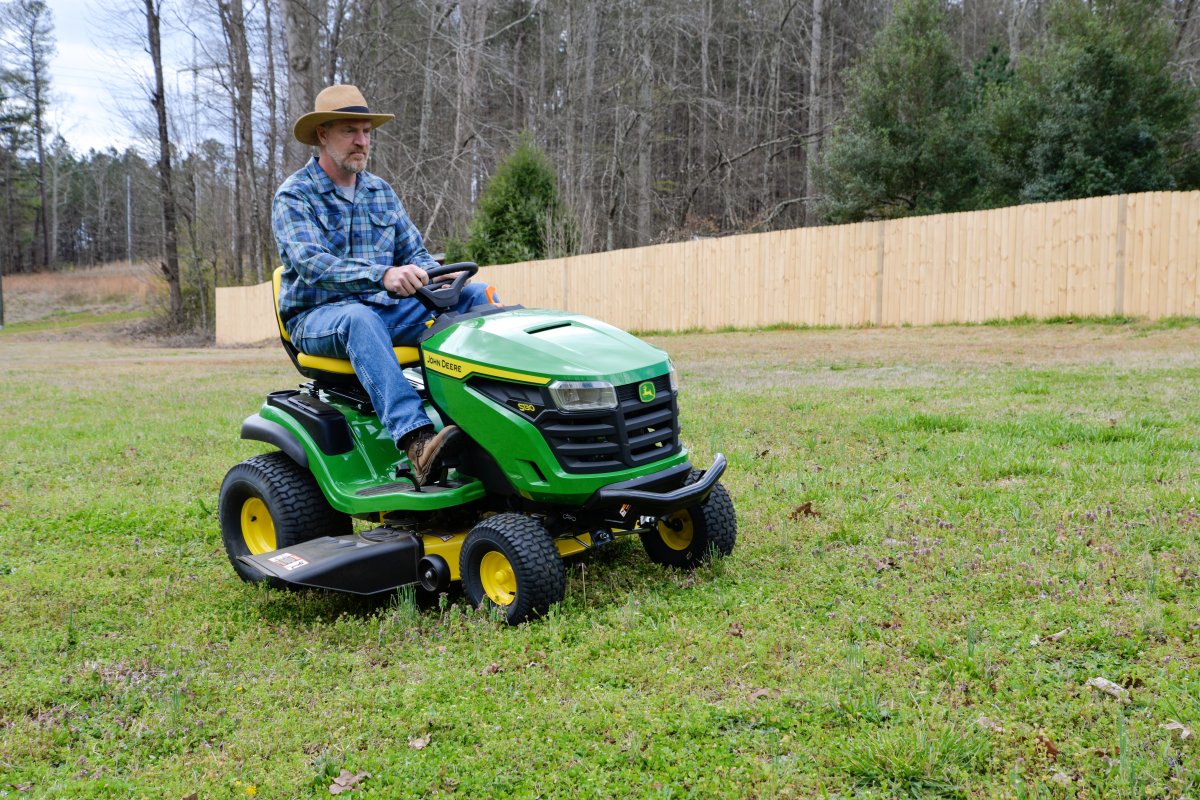
FAQs
There is a lot to consider when choosing the best riding lawn mower for hills. For a quick reference to your most pressing queries, check out this section of frequently asked questions to get more information.
Zero-turn mowers are good on hills with modest slopes up to 15 degrees. Beyond 15 degrees, traction can become an issue for these mowers, causing them to slip and slide down a hill, so it’s important to use them within their capabilities. Some manufacturers suggest only mowing downhill in a zero-turn mower.
Always mow up and down the slope in straight lines. Mowing parallel or executing turns on the slope increases the risk of a rollover accident. This bucks the traditional advice of mowing side-to-side with a push mower.
Keep the mower in low gear to reduce the possibility of running down the slope. Mow in an up-and-down pattern rather than along the length of the ditch. Excessively steep ditches should not be mowed with a rider. In these cases, it may be better to use a string trimmer to cut the grass, or opt for a push mower for larger ditches.
Most riding lawn mowers should mow slopes no steeper than 20 degrees. Reduce that number to 15 degrees for most zero-turn mowers as they are more prone to tipping over backward on steep hills. However, following the manufacturer’s instructions should take precedence here, as they test their machines for safe usage and may be liable if something happens within the range they state is safe.
In flat, open spaces, lawn tractors can mow at speeds in excess of 4 mph, while zero-turn riding lawn mowers may top 8 mph. However, operating safely on slopes requires a slower pace for better control and balance.
Meet the Tester
With more than 20 years of experience in the nursery and landscaping industries, Mark Wolfe is a writer and product tester who reviews all the latest outdoor power equipment, hand tools, lawn care products, and other outdoor-living goods.
Additional research provided by Mike Bruton and Tom Scalisi.
